Public Health Report: Community Health in the UK - PUBH 4
VerifiedAdded on 2022/08/21
|7
|1650
|12
Report
AI Summary
This report examines the health and well-being of the African British community in the UK, with a specific focus on hypertension and diabetes. It explores the social determinants of health, including socioeconomic status, education, and access to healthcare, and their impact on disease prevalence. The report defines health and well-being, analyzes health and wellness, and discusses the biopsychosocial model and the health belief model as frameworks for health service delivery and intervention. It highlights the importance of culturally competent care and community engagement in addressing health disparities. The report concludes by emphasizing the role of these models in addressing hypertension and diabetes within the Black British community, referencing relevant research and studies.
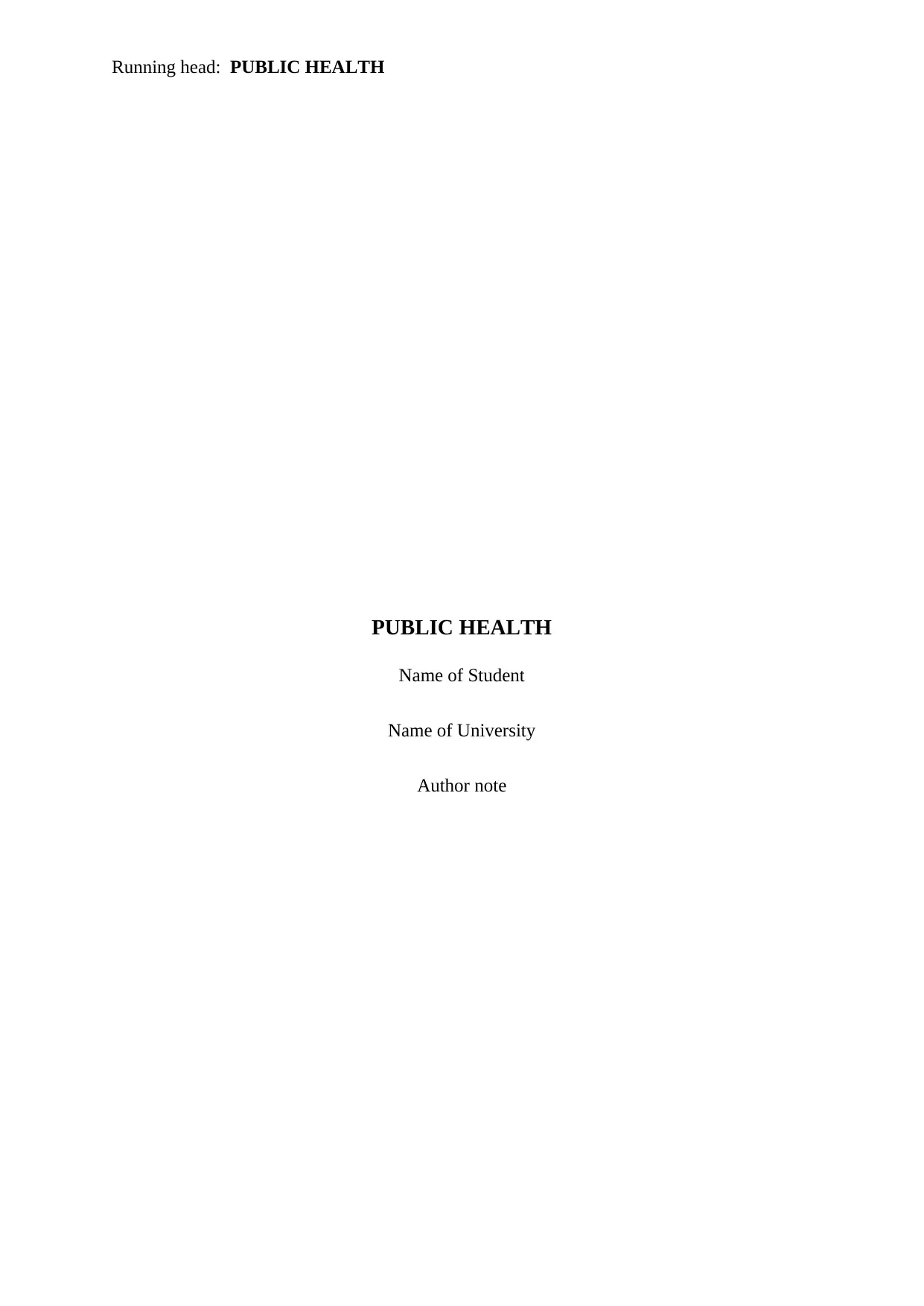
Running head: PUBLIC HEALTH
PUBLIC HEALTH
Name of Student
Name of University
Author note
PUBLIC HEALTH
Name of Student
Name of University
Author note
Paraphrase This Document
Need a fresh take? Get an instant paraphrase of this document with our AI Paraphraser
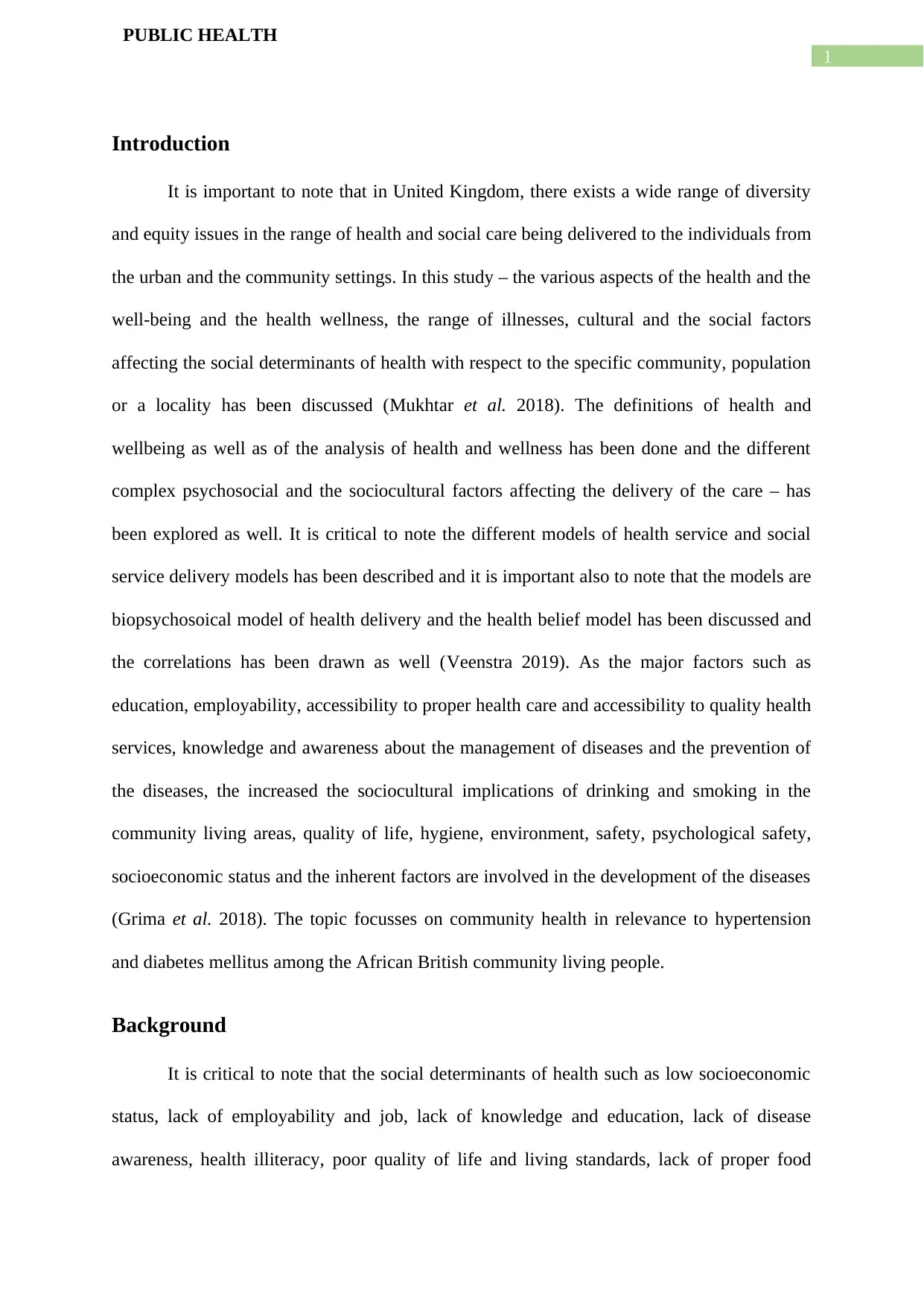
1
PUBLIC HEALTH
Introduction
It is important to note that in United Kingdom, there exists a wide range of diversity
and equity issues in the range of health and social care being delivered to the individuals from
the urban and the community settings. In this study – the various aspects of the health and the
well-being and the health wellness, the range of illnesses, cultural and the social factors
affecting the social determinants of health with respect to the specific community, population
or a locality has been discussed (Mukhtar et al. 2018). The definitions of health and
wellbeing as well as of the analysis of health and wellness has been done and the different
complex psychosocial and the sociocultural factors affecting the delivery of the care – has
been explored as well. It is critical to note the different models of health service and social
service delivery models has been described and it is important also to note that the models are
biopsychosoical model of health delivery and the health belief model has been discussed and
the correlations has been drawn as well (Veenstra 2019). As the major factors such as
education, employability, accessibility to proper health care and accessibility to quality health
services, knowledge and awareness about the management of diseases and the prevention of
the diseases, the increased the sociocultural implications of drinking and smoking in the
community living areas, quality of life, hygiene, environment, safety, psychological safety,
socioeconomic status and the inherent factors are involved in the development of the diseases
(Grima et al. 2018). The topic focusses on community health in relevance to hypertension
and diabetes mellitus among the African British community living people.
Background
It is critical to note that the social determinants of health such as low socioeconomic
status, lack of employability and job, lack of knowledge and education, lack of disease
awareness, health illiteracy, poor quality of life and living standards, lack of proper food
PUBLIC HEALTH
Introduction
It is important to note that in United Kingdom, there exists a wide range of diversity
and equity issues in the range of health and social care being delivered to the individuals from
the urban and the community settings. In this study – the various aspects of the health and the
well-being and the health wellness, the range of illnesses, cultural and the social factors
affecting the social determinants of health with respect to the specific community, population
or a locality has been discussed (Mukhtar et al. 2018). The definitions of health and
wellbeing as well as of the analysis of health and wellness has been done and the different
complex psychosocial and the sociocultural factors affecting the delivery of the care – has
been explored as well. It is critical to note the different models of health service and social
service delivery models has been described and it is important also to note that the models are
biopsychosoical model of health delivery and the health belief model has been discussed and
the correlations has been drawn as well (Veenstra 2019). As the major factors such as
education, employability, accessibility to proper health care and accessibility to quality health
services, knowledge and awareness about the management of diseases and the prevention of
the diseases, the increased the sociocultural implications of drinking and smoking in the
community living areas, quality of life, hygiene, environment, safety, psychological safety,
socioeconomic status and the inherent factors are involved in the development of the diseases
(Grima et al. 2018). The topic focusses on community health in relevance to hypertension
and diabetes mellitus among the African British community living people.
Background
It is critical to note that the social determinants of health such as low socioeconomic
status, lack of employability and job, lack of knowledge and education, lack of disease
awareness, health illiteracy, poor quality of life and living standards, lack of proper food
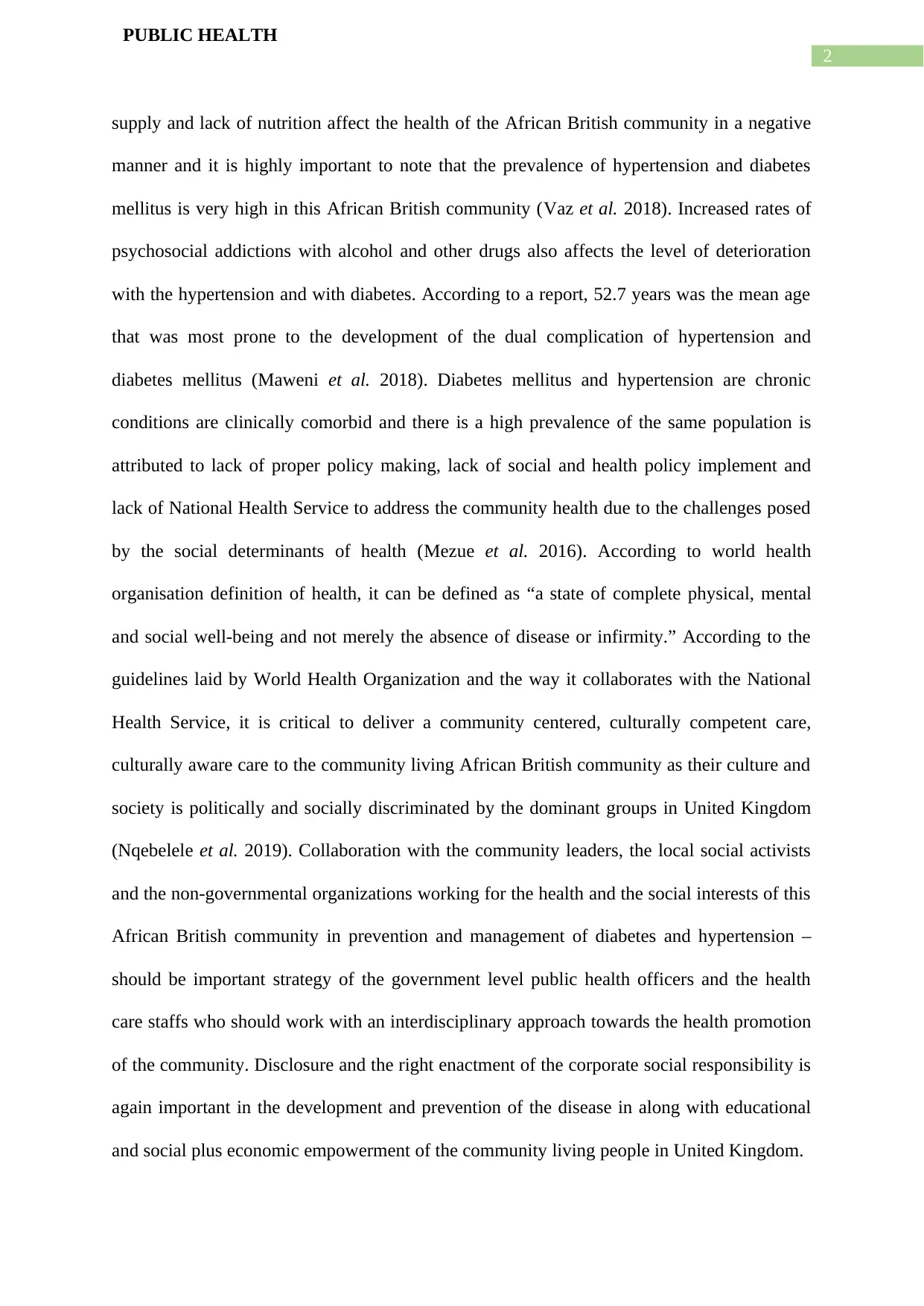
2
PUBLIC HEALTH
supply and lack of nutrition affect the health of the African British community in a negative
manner and it is highly important to note that the prevalence of hypertension and diabetes
mellitus is very high in this African British community (Vaz et al. 2018). Increased rates of
psychosocial addictions with alcohol and other drugs also affects the level of deterioration
with the hypertension and with diabetes. According to a report, 52.7 years was the mean age
that was most prone to the development of the dual complication of hypertension and
diabetes mellitus (Maweni et al. 2018). Diabetes mellitus and hypertension are chronic
conditions are clinically comorbid and there is a high prevalence of the same population is
attributed to lack of proper policy making, lack of social and health policy implement and
lack of National Health Service to address the community health due to the challenges posed
by the social determinants of health (Mezue et al. 2016). According to world health
organisation definition of health, it can be defined as “a state of complete physical, mental
and social well-being and not merely the absence of disease or infirmity.” According to the
guidelines laid by World Health Organization and the way it collaborates with the National
Health Service, it is critical to deliver a community centered, culturally competent care,
culturally aware care to the community living African British community as their culture and
society is politically and socially discriminated by the dominant groups in United Kingdom
(Nqebelele et al. 2019). Collaboration with the community leaders, the local social activists
and the non-governmental organizations working for the health and the social interests of this
African British community in prevention and management of diabetes and hypertension –
should be important strategy of the government level public health officers and the health
care staffs who should work with an interdisciplinary approach towards the health promotion
of the community. Disclosure and the right enactment of the corporate social responsibility is
again important in the development and prevention of the disease in along with educational
and social plus economic empowerment of the community living people in United Kingdom.
PUBLIC HEALTH
supply and lack of nutrition affect the health of the African British community in a negative
manner and it is highly important to note that the prevalence of hypertension and diabetes
mellitus is very high in this African British community (Vaz et al. 2018). Increased rates of
psychosocial addictions with alcohol and other drugs also affects the level of deterioration
with the hypertension and with diabetes. According to a report, 52.7 years was the mean age
that was most prone to the development of the dual complication of hypertension and
diabetes mellitus (Maweni et al. 2018). Diabetes mellitus and hypertension are chronic
conditions are clinically comorbid and there is a high prevalence of the same population is
attributed to lack of proper policy making, lack of social and health policy implement and
lack of National Health Service to address the community health due to the challenges posed
by the social determinants of health (Mezue et al. 2016). According to world health
organisation definition of health, it can be defined as “a state of complete physical, mental
and social well-being and not merely the absence of disease or infirmity.” According to the
guidelines laid by World Health Organization and the way it collaborates with the National
Health Service, it is critical to deliver a community centered, culturally competent care,
culturally aware care to the community living African British community as their culture and
society is politically and socially discriminated by the dominant groups in United Kingdom
(Nqebelele et al. 2019). Collaboration with the community leaders, the local social activists
and the non-governmental organizations working for the health and the social interests of this
African British community in prevention and management of diabetes and hypertension –
should be important strategy of the government level public health officers and the health
care staffs who should work with an interdisciplinary approach towards the health promotion
of the community. Disclosure and the right enactment of the corporate social responsibility is
again important in the development and prevention of the disease in along with educational
and social plus economic empowerment of the community living people in United Kingdom.
⊘ This is a preview!⊘
Do you want full access?
Subscribe today to unlock all pages.

Trusted by 1+ million students worldwide
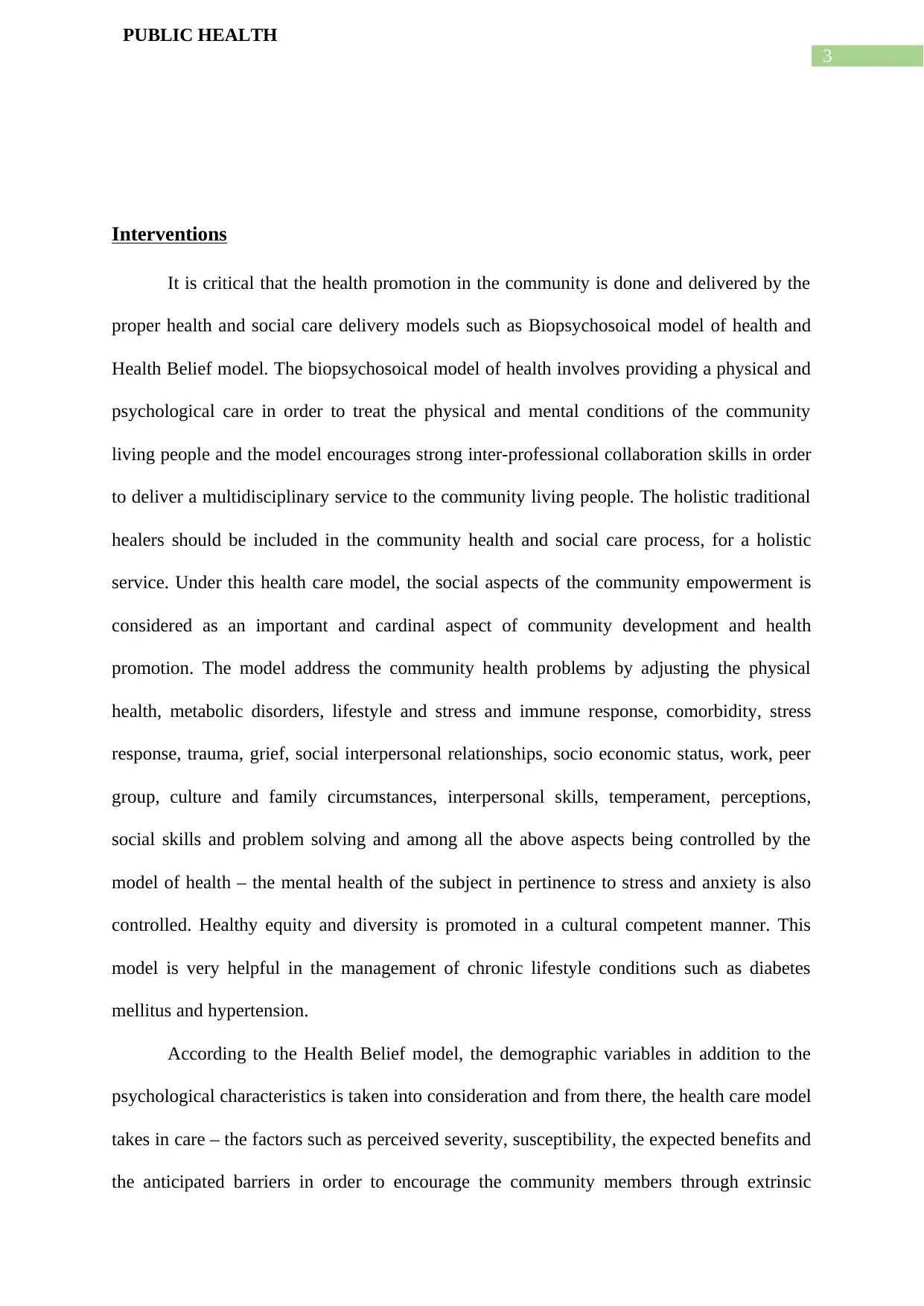
3
PUBLIC HEALTH
Interventions
It is critical that the health promotion in the community is done and delivered by the
proper health and social care delivery models such as Biopsychosoical model of health and
Health Belief model. The biopsychosoical model of health involves providing a physical and
psychological care in order to treat the physical and mental conditions of the community
living people and the model encourages strong inter-professional collaboration skills in order
to deliver a multidisciplinary service to the community living people. The holistic traditional
healers should be included in the community health and social care process, for a holistic
service. Under this health care model, the social aspects of the community empowerment is
considered as an important and cardinal aspect of community development and health
promotion. The model address the community health problems by adjusting the physical
health, metabolic disorders, lifestyle and stress and immune response, comorbidity, stress
response, trauma, grief, social interpersonal relationships, socio economic status, work, peer
group, culture and family circumstances, interpersonal skills, temperament, perceptions,
social skills and problem solving and among all the above aspects being controlled by the
model of health – the mental health of the subject in pertinence to stress and anxiety is also
controlled. Healthy equity and diversity is promoted in a cultural competent manner. This
model is very helpful in the management of chronic lifestyle conditions such as diabetes
mellitus and hypertension.
According to the Health Belief model, the demographic variables in addition to the
psychological characteristics is taken into consideration and from there, the health care model
takes in care – the factors such as perceived severity, susceptibility, the expected benefits and
the anticipated barriers in order to encourage the community members through extrinsic
PUBLIC HEALTH
Interventions
It is critical that the health promotion in the community is done and delivered by the
proper health and social care delivery models such as Biopsychosoical model of health and
Health Belief model. The biopsychosoical model of health involves providing a physical and
psychological care in order to treat the physical and mental conditions of the community
living people and the model encourages strong inter-professional collaboration skills in order
to deliver a multidisciplinary service to the community living people. The holistic traditional
healers should be included in the community health and social care process, for a holistic
service. Under this health care model, the social aspects of the community empowerment is
considered as an important and cardinal aspect of community development and health
promotion. The model address the community health problems by adjusting the physical
health, metabolic disorders, lifestyle and stress and immune response, comorbidity, stress
response, trauma, grief, social interpersonal relationships, socio economic status, work, peer
group, culture and family circumstances, interpersonal skills, temperament, perceptions,
social skills and problem solving and among all the above aspects being controlled by the
model of health – the mental health of the subject in pertinence to stress and anxiety is also
controlled. Healthy equity and diversity is promoted in a cultural competent manner. This
model is very helpful in the management of chronic lifestyle conditions such as diabetes
mellitus and hypertension.
According to the Health Belief model, the demographic variables in addition to the
psychological characteristics is taken into consideration and from there, the health care model
takes in care – the factors such as perceived severity, susceptibility, the expected benefits and
the anticipated barriers in order to encourage the community members through extrinsic
Paraphrase This Document
Need a fresh take? Get an instant paraphrase of this document with our AI Paraphraser
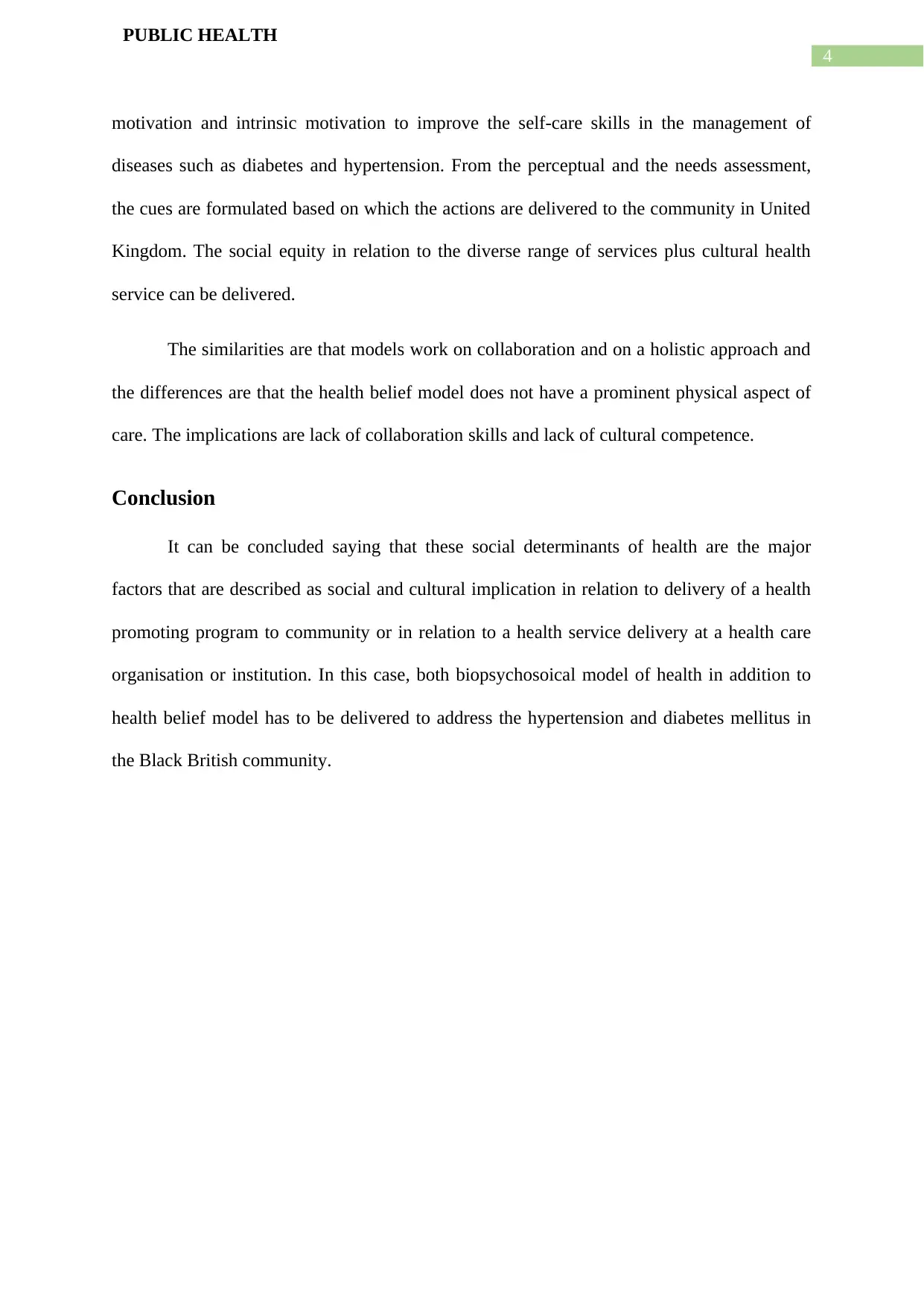
4
PUBLIC HEALTH
motivation and intrinsic motivation to improve the self-care skills in the management of
diseases such as diabetes and hypertension. From the perceptual and the needs assessment,
the cues are formulated based on which the actions are delivered to the community in United
Kingdom. The social equity in relation to the diverse range of services plus cultural health
service can be delivered.
The similarities are that models work on collaboration and on a holistic approach and
the differences are that the health belief model does not have a prominent physical aspect of
care. The implications are lack of collaboration skills and lack of cultural competence.
Conclusion
It can be concluded saying that these social determinants of health are the major
factors that are described as social and cultural implication in relation to delivery of a health
promoting program to community or in relation to a health service delivery at a health care
organisation or institution. In this case, both biopsychosoical model of health in addition to
health belief model has to be delivered to address the hypertension and diabetes mellitus in
the Black British community.
PUBLIC HEALTH
motivation and intrinsic motivation to improve the self-care skills in the management of
diseases such as diabetes and hypertension. From the perceptual and the needs assessment,
the cues are formulated based on which the actions are delivered to the community in United
Kingdom. The social equity in relation to the diverse range of services plus cultural health
service can be delivered.
The similarities are that models work on collaboration and on a holistic approach and
the differences are that the health belief model does not have a prominent physical aspect of
care. The implications are lack of collaboration skills and lack of cultural competence.
Conclusion
It can be concluded saying that these social determinants of health are the major
factors that are described as social and cultural implication in relation to delivery of a health
promoting program to community or in relation to a health service delivery at a health care
organisation or institution. In this case, both biopsychosoical model of health in addition to
health belief model has to be delivered to address the hypertension and diabetes mellitus in
the Black British community.
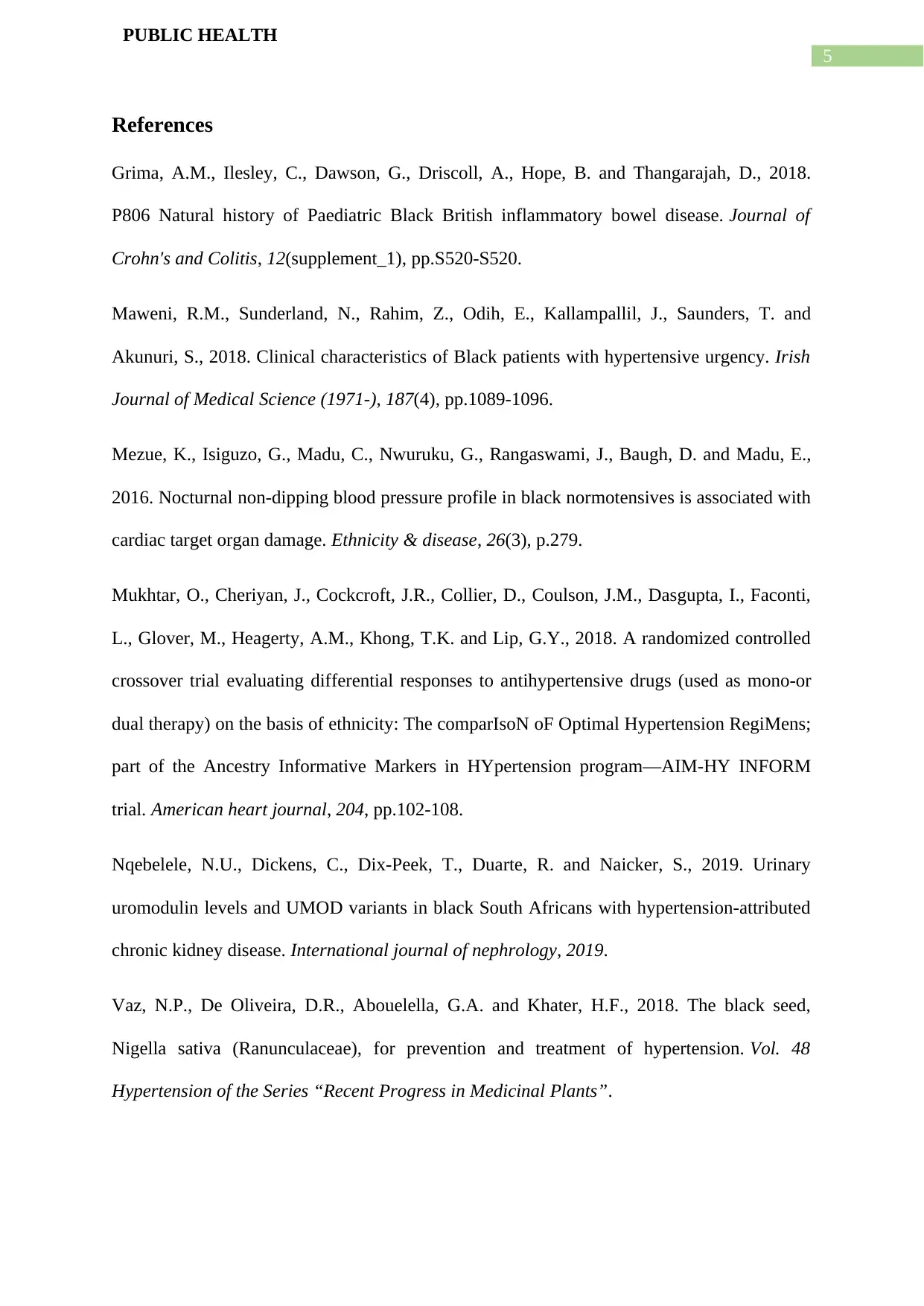
5
PUBLIC HEALTH
References
Grima, A.M., Ilesley, C., Dawson, G., Driscoll, A., Hope, B. and Thangarajah, D., 2018.
P806 Natural history of Paediatric Black British inflammatory bowel disease. Journal of
Crohn's and Colitis, 12(supplement_1), pp.S520-S520.
Maweni, R.M., Sunderland, N., Rahim, Z., Odih, E., Kallampallil, J., Saunders, T. and
Akunuri, S., 2018. Clinical characteristics of Black patients with hypertensive urgency. Irish
Journal of Medical Science (1971-), 187(4), pp.1089-1096.
Mezue, K., Isiguzo, G., Madu, C., Nwuruku, G., Rangaswami, J., Baugh, D. and Madu, E.,
2016. Nocturnal non-dipping blood pressure profile in black normotensives is associated with
cardiac target organ damage. Ethnicity & disease, 26(3), p.279.
Mukhtar, O., Cheriyan, J., Cockcroft, J.R., Collier, D., Coulson, J.M., Dasgupta, I., Faconti,
L., Glover, M., Heagerty, A.M., Khong, T.K. and Lip, G.Y., 2018. A randomized controlled
crossover trial evaluating differential responses to antihypertensive drugs (used as mono-or
dual therapy) on the basis of ethnicity: The comparIsoN oF Optimal Hypertension RegiMens;
part of the Ancestry Informative Markers in HYpertension program—AIM-HY INFORM
trial. American heart journal, 204, pp.102-108.
Nqebelele, N.U., Dickens, C., Dix-Peek, T., Duarte, R. and Naicker, S., 2019. Urinary
uromodulin levels and UMOD variants in black South Africans with hypertension-attributed
chronic kidney disease. International journal of nephrology, 2019.
Vaz, N.P., De Oliveira, D.R., Abouelella, G.A. and Khater, H.F., 2018. The black seed,
Nigella sativa (Ranunculaceae), for prevention and treatment of hypertension. Vol. 48
Hypertension of the Series “Recent Progress in Medicinal Plants”.
PUBLIC HEALTH
References
Grima, A.M., Ilesley, C., Dawson, G., Driscoll, A., Hope, B. and Thangarajah, D., 2018.
P806 Natural history of Paediatric Black British inflammatory bowel disease. Journal of
Crohn's and Colitis, 12(supplement_1), pp.S520-S520.
Maweni, R.M., Sunderland, N., Rahim, Z., Odih, E., Kallampallil, J., Saunders, T. and
Akunuri, S., 2018. Clinical characteristics of Black patients with hypertensive urgency. Irish
Journal of Medical Science (1971-), 187(4), pp.1089-1096.
Mezue, K., Isiguzo, G., Madu, C., Nwuruku, G., Rangaswami, J., Baugh, D. and Madu, E.,
2016. Nocturnal non-dipping blood pressure profile in black normotensives is associated with
cardiac target organ damage. Ethnicity & disease, 26(3), p.279.
Mukhtar, O., Cheriyan, J., Cockcroft, J.R., Collier, D., Coulson, J.M., Dasgupta, I., Faconti,
L., Glover, M., Heagerty, A.M., Khong, T.K. and Lip, G.Y., 2018. A randomized controlled
crossover trial evaluating differential responses to antihypertensive drugs (used as mono-or
dual therapy) on the basis of ethnicity: The comparIsoN oF Optimal Hypertension RegiMens;
part of the Ancestry Informative Markers in HYpertension program—AIM-HY INFORM
trial. American heart journal, 204, pp.102-108.
Nqebelele, N.U., Dickens, C., Dix-Peek, T., Duarte, R. and Naicker, S., 2019. Urinary
uromodulin levels and UMOD variants in black South Africans with hypertension-attributed
chronic kidney disease. International journal of nephrology, 2019.
Vaz, N.P., De Oliveira, D.R., Abouelella, G.A. and Khater, H.F., 2018. The black seed,
Nigella sativa (Ranunculaceae), for prevention and treatment of hypertension. Vol. 48
Hypertension of the Series “Recent Progress in Medicinal Plants”.
⊘ This is a preview!⊘
Do you want full access?
Subscribe today to unlock all pages.

Trusted by 1+ million students worldwide

6
PUBLIC HEALTH
Veenstra, G., 2019. Black, White, Black and White: mixed race and health in
Canada. Ethnicity & health, 24(2), pp.113-124.
PUBLIC HEALTH
Veenstra, G., 2019. Black, White, Black and White: mixed race and health in
Canada. Ethnicity & health, 24(2), pp.113-124.
1 out of 7
Related Documents
Your All-in-One AI-Powered Toolkit for Academic Success.
+13062052269
info@desklib.com
Available 24*7 on WhatsApp / Email
![[object Object]](/_next/static/media/star-bottom.7253800d.svg)
Unlock your academic potential
Copyright © 2020–2025 A2Z Services. All Rights Reserved. Developed and managed by ZUCOL.





